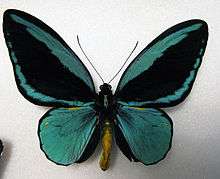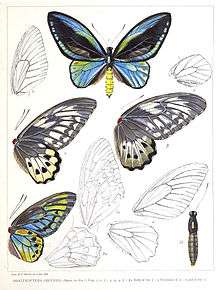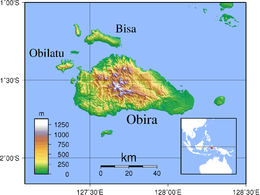Ornithoptera aesacus
Ornithoptera aesacus, the Obi Island birdwing, is a rare species of birdwing butterfly, endemic to the Island of Obira (formerly Obi), Indonesia.[2]
| Obi Island birdwing | |
|---|---|
 | |
| Male, mounted specimen | |
| Scientific classification | |
| Kingdom: | |
| Phylum: | |
| Class: | |
| Order: | |
| Family: | |
| Genus: | |
| Species: | O. aesacus |
| Binomial name | |
| Ornithoptera aesacus Ney, 1903 | |
The specific epithet of Ornithoptera aesacus, is named after Æsacus, the eldest son of Priam.
History

The original description is: aesacus Ney, F. 1903 as Troides priamus Form aesacus. The full reference is Ney, F. 1903 Eine neue Troides-Form von Obi. Insekten-Börse 20 (5): 36., 1903.
The depository of the four syntypes collected by J. Waterstradt in May 1902 is unknown. They were once held by Hermann Rolle, whose collection, in part, was sold to Eugène Le Moult.
Description
Ornithoptera aesacus is a member of the Ornithoptera priamus species group. The two species are very similar but the male O. aesacus has a brilliant turquoise-blue sheen.
Taxonomy
The classification of Ornithoptera aesacus as a species does not have full consensus, and is sometimes regarded as a subspecies of Ornithoptera priamus by some, such as Parsons (1996).
Synonymy
- O. obiana (Waterstradt in litt.) Rebel, 1906
- O. obiensis Rippon, 1906
- O. obiana (as O. arruana obiana) Rippon, 1906-1912
Distribution

The Obi Island birdwing is endemic to the Island of Obira in Indonesia.[2] It inhabits tropical rainforest. Due to extensive logging on the Island the conservation of the species is a concern, and has been classified as 'Vulnerable' by the IUCN[1] Twenty years ago it was the rarest birdwing species in the world. It remains threatened, but is commercially bred.
References
- Gimenez Dixon, M. (1996). "Ornithoptera aesacus". IUCN Red List of Threatened Species. 1996: e.T15511A4710720. doi:10.2305/IUCN.UK.1996.RLTS.T15511A4710720.en.
- Global Biodiversity Information Facility, record for Ornithoptera aesacus
- D'Abrera, B. (1975). Birdwing Butterflies of the World. Country Life Books, London.
- Collins, N. Mark; Morris, Michael G. (1985). Threatened Swallowtail Butterflies of the World: The IUCN Red Data Book. Gland & Cambridge: IUCN. ISBN 978-2-88032-603-6 – via Biodiversity Heritage Library.
- Haugum, J. & Low, A.M. (1978-1985). A Monograph of the Birdwing Butterflies. 2 volumes. Scandinavian Press, Klampenborg; 663 pp.
- Parsons, M.J. (1996). A phylogenetic reappraisal of the birdwing genus Ornithoptera (Lepidoptera: Papilionidae: Troidini) and a new theory of its evolution in relation to Gondwanan vicariance biogeography. Journal of Natural History 30(11):1707-1736.
External links

- Globis.insects-online: Ornithoptera aesacus — from Zoologische Staatssammlung München.
- Barcode of Life: Ornithoptera aesacus — from Consortium for the Barcode of Life.
- Att.net.bret69: Images of Swallowtails
- Nagypal.net: Images
- Worldwildlife.org: Southeastern Asia Ecoregion — "Islands of Halmahera, Moratai"
| Wikimedia Commons has media related to Ornithoptera aesacus. |
